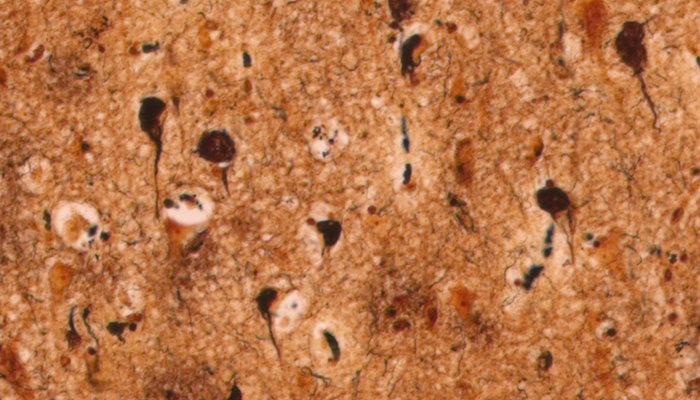
The dark shapes are dying/dead neurons filled with tau tangles in an Alzheimer's diseased brain. (credit: QBI)
QBI researchers are a step closer to understanding why a toxic protein builds up in brain cells dying from Alzheimer's disease.
Scientists in QBI’s Clem Jones Centre for Ageing Dementia Research discovered that an enzyme, Fyn, plays a key role in the accumulation of toxic tau protein inside neurons.
CJCADR director Professor Jürgen Götz said Alzheimer’s disease is characterised by the build-up two types of proteins in the brain: amyloid-beta, which forms plaques, and tau.
“Previously, it wasn’t fully understood why tau accumulates in dying neurons in Alzheimer’s disease,” he said.
Tau normally plays an important role in maintaining the structure of a neuron’s axon, the long cable part of a brain cell that transmits signals. In Alzheimer’s disease, it forms large deposits known as ‘neurofibrillary tangles’ – clumps in the cell body where normally very little tau is found. The tangles interfere with the neuron’s function, eventually killing it.
Previously, it was thought that tau undergoes a change in its structure in the axons of neurons and then migrates to the cell body of a neuron, where it then accumulates.
New theory for tau accumulation in Alzheimer's disease
“Dr Chuanzhou Li has come up with a new mechanism to explain why tau accumulates in the cell body of neurons,” said Professor Götz.
“Excitingly, we’ve found that an important enzyme, Fyn, activates enzymes that trigger the synthesis of tau in the cell body where tau then accumulates and forms tangles."
The discovery opens up new potential avenues for treating Alzheimer’s disease. Understanding why these toxic proteins build up will enable QBI researchers to find new ways of preventing it from happening.
Earlier this year, CJCADR researchers, led by Professor Götz, built on their breakthrough using ultrasound technology to treat Alzheimer’s disease and restore memory in animal models.
They found that ultrasound enhances the effectiveness of immunotherapy in reducing toxic tau protein build-up – combining ultrasound with an antibody fragment was more effective than either treatment alone in removing protein clumps and reducing Alzheimer’s symptoms in mice.
Understanding why tau accumulates and uncovering what happens in the brain at a cellular level is crucial to QBI’s goal of preventing and treating of dementia.
The research is published online in EMBO, and was made possible through the support of the Federal government, the Queensland government through the Department of Science, IT and Innovation, and philanthropic support led by the Clem Jones Foundation.




